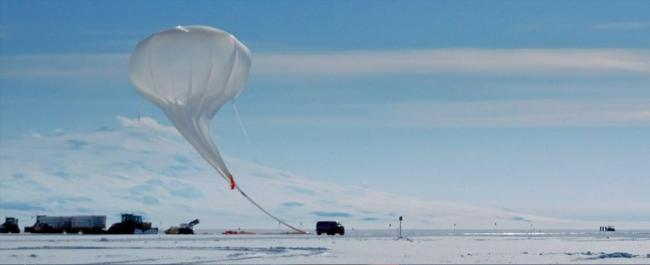Stratospheric Terahertz Observatory 1&2
The Milky Way is full of clouds of gas and dust, which are the places where new stars and planets are born. These molecular clouds clump together and break apart over time, such that understanding their evolution requires observing them at various stages of their lives. However, much of the light emitted by these clouds is blocked by Earth’s atmosphere. To get above most of the light-blocking air, NASA’s Stratospheric Terahertz Observatory (STO) is an infrared telescope flown on a special high-altitude balloon 40 kilometers (25 miles) over Antarctica. Center for Astrophysics | Harvard & Smithsonian researchers were involved with the development of the first STO mission, which flew for 14 days in 2012; the second mission, STO2, operated for three weeks in 2016.
The Telescope and the Science
The interstellar medium (ISM) is the matter lying between stars, and it contains all the ingredients for new stars and planets. Those ingredients reside in interstellar clouds which form, change shape over time, and eventually disperse. At their coldest and most dense, they become stellar nurseries, providing the environment and materials needed for newborn stars and their planets. Understanding the changes of the physical and chemical environment of the ISM is essential for following the cycles of star birth and death, and the possibilities of life elsewhere in the galaxy.
However, the light emitted by many molecules in the ISM is absorbed by water vapor in Earth’s atmosphere. STO was built to fly high enough above the highest concentrations of atmospheric water vapor, in the clear dry Antarctic skies. At an altitude of 40 kilometers — three times higher than commercial airplanes fly — the atmosphere is thinner in general, providing a much clearer view of the galaxy. NASA has developed high-pressure balloons for such experiments, which are capable of rising high in the stratosphere and remaining there for weeks at a time. The NASA balloon carrying STO took advantage of the stable Antarctic polar wind to stay aloft for 14 days in 2014, while STO-2 flew for three weeks in 2016.
Detectors on the STO and STO-2 missions observed light with frequencies of 1.4 and 1.9 terahertz, which lie in the far infrared portion of the spectrum. This type of light is emitted by ionized nitrogen and carbon in interstellar molecular clouds, which are present during star formation. STO-2 used the same telescope as STO, but added a third detector to identify oxygen from newborn stars; however, technical difficulties prevented data from this detector from being collected. The telescope is designed to distinguish details within the ISM, to understand the processes of molecular cloud evolution and star formation. The detector on the telescope is a bolometer, which is a superconducting device operating at a fraction of a degree above absolute zero for accurate measurement of the light coming in.
STO is an international collaboration led by the University of Arizona, with hardware contributions from the Jet Propulsion Institute (JPL), the Netherlands Institute for Space Research (SRON), and the Delft University of Technology. CfA scientists participated primarily in the scientific observations and their analysis of both STO and STO-2 missions, which also involved a number of other institutions from around the world.

The launch of the NASA Super-Pressure Balloon carrying the Stratospheric Terahertz Observatory from McMurdo Station in Antarctica on December 8, 2016. This high-altitude flight took the observatory above the thickest part of Earth's atmosphere.